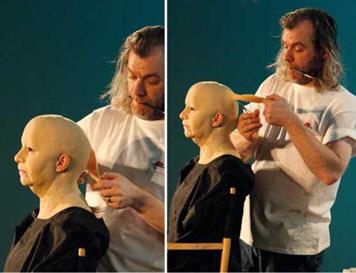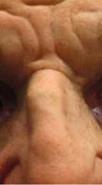 Concealing appliance edges is what helps sell the believability of your makeup. If your appliances have been made well to begin with, blending off the edges is not particularly difficult. You do need to be conscious of very thin edges and not let them fold over on themselves, which can cause them to stick, and then they can be difficult to separate and even tear. If your edges are thicker than they should be or if they’ve torn or wrinkled, the following, or many variations, may work to conceal edges and overlaps. I will also caution you at this point that if you are working
Concealing appliance edges is what helps sell the believability of your makeup. If your appliances have been made well to begin with, blending off the edges is not particularly difficult. You do need to be conscious of very thin edges and not let them fold over on themselves, which can cause them to stick, and then they can be difficult to separate and even tear. If your edges are thicker than they should be or if they’ve torn or wrinkled, the following, or many variations, may work to conceal edges and overlaps. I will also caution you at this point that if you are working
![]()


 with an appliance that has previously been applied and had makeup on it, such as a Ben Nye® creme foundation, or something other than a Skin Illustrator® palette, Sta-Color palette, or Temptu® Pro palette, concealing edges might be difficult if not impossible because none of the materials commonly used for blending and concealing edges will adhere well to makeup and they will come loose. Any residual makeup must be completely removed and cleaned so that there is no residual oil left from the makeup to inhibit the adhesive used for hiding edges.
with an appliance that has previously been applied and had makeup on it, such as a Ben Nye® creme foundation, or something other than a Skin Illustrator® palette, Sta-Color palette, or Temptu® Pro palette, concealing edges might be difficult if not impossible because none of the materials commonly used for blending and concealing edges will adhere well to makeup and they will come loose. Any residual makeup must be completely removed and cleaned so that there is no residual oil left from the makeup to inhibit the adhesive used for hiding edges.
So let’s assume you are applying a fresh, unused appliance for the first time:
1. Apply the piece as described previously with your adhesive of choice.
2. If the edges are thick, Pros-Aide® bondo or Cabo patch can be applied with a small brush, Q-tip®, or dental spatula to cover the edge, and smoothed with a brush dipped in water or 99 percent IPA to blend away the edge. Use a blow dryer to dry it and then powder because it will be tacky.
3. Pros-Aide® can also be applied by itself to help blend away the edges by applying with a piece of stipple sponge or latex makeup sponge. Because Pros-Aide is a water-based acrylic adhesive, if it’s left out and exposed to the air the water will evaporate, making the adhesive thicker.
4. Interestingly enough, Duo® false eyelash glue also works fairly well as an edge blender, as does liquid latex, though if you use latex to blend or conceal edges you will most likely need to dab the latex with castor sealer in order for the makeup you apply next to match makeup applied to the rest of the appliance or skin.
There is really no method I can tell you that will be the be-all and end-all way to conceal edges. Obviously the best way to hide edges is for the edges to be virtually invisible to begin with and glued with care. Rushing will betray you. Do not be in a hurry at this stage of the makeup because it will come back to bite you. Redoing the makeup will take far longer than doing it well and doing it right the first time.
However, there is a method of concealing edges that can make your life easier; it
involves using the plastic cap material mentioned in the preceding section about attaching the appliance. If your edges are made of the cap material (if you’ve created a GFA with cap material as your encapsulating material), they can be dissolved away with 99 percent IPA (isopropyl alcohol), witch hazel, or acetone.
Now, if the adhesive you are using is a silicone adhesive such as Telesis® 5, your appliance edges can be worked and reworked with a small brush dipped in Telesis ® thinner. The thinner will slightly swell the silicone edge, popping it out and allowing
you to press the edge back into its proper position. This works very well if an edge has curled over on itself and stuck together; the thinner will allow it to come back apart and be set right. Then you can proceed to complete the application and blend all the edges invisibly.
Applying Pros-Aide® along edges can be done with a Q-tip® or cotton swab, but you must be careful not to let the adhesive begin to dry or you will risk getting fibers from the cotton tip embedded in the adhesive. There are a number of small brushes that can be purchased in bulk that will allow you to do the same thing without the risk of getting errant fibers caught.
